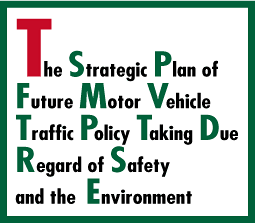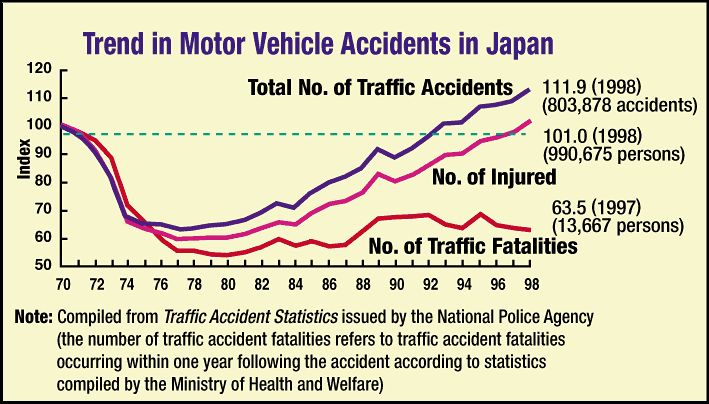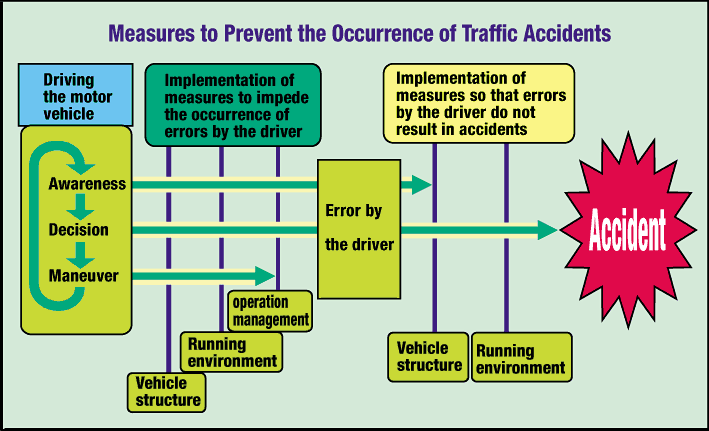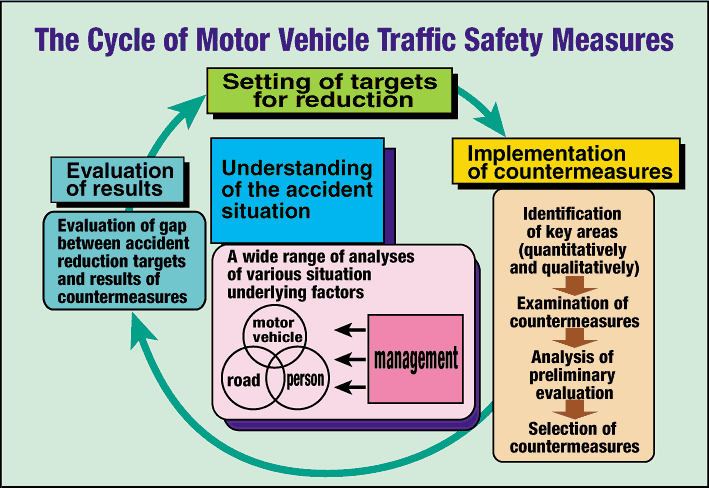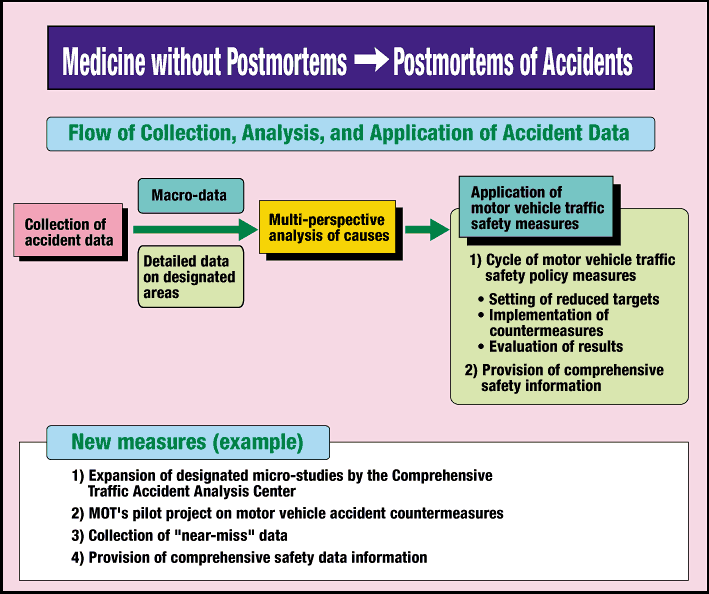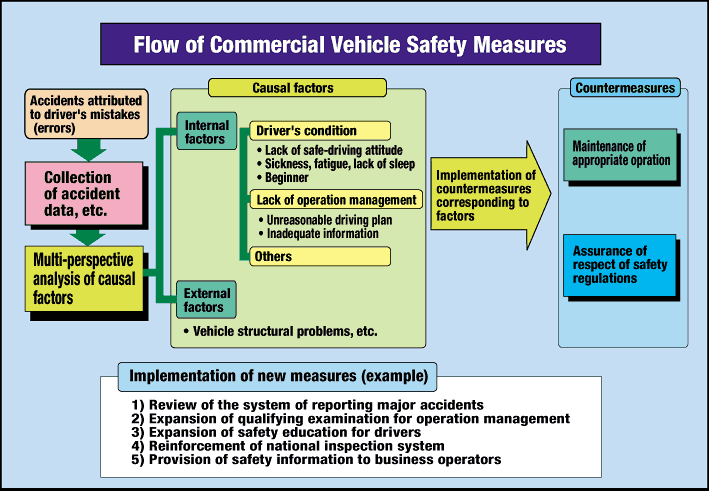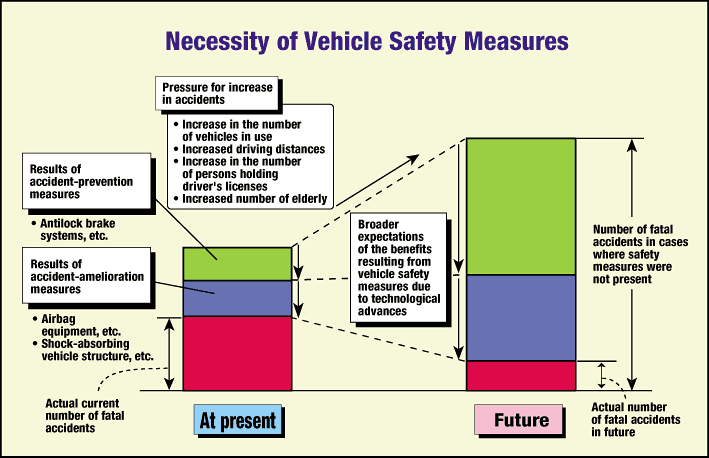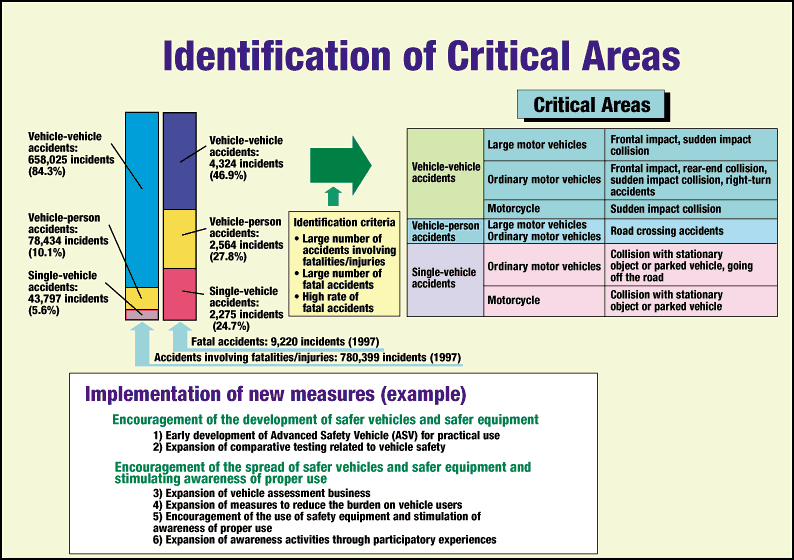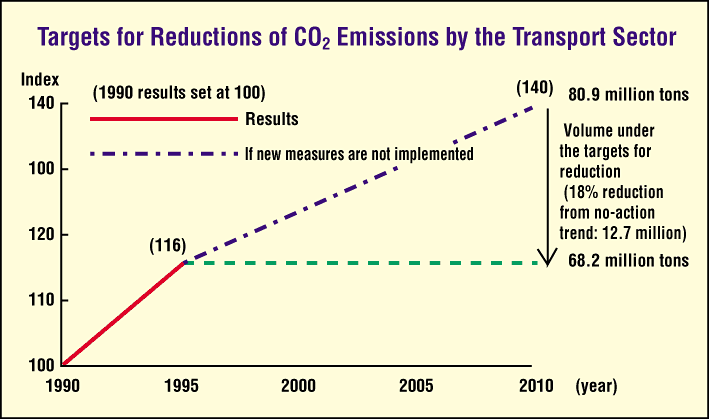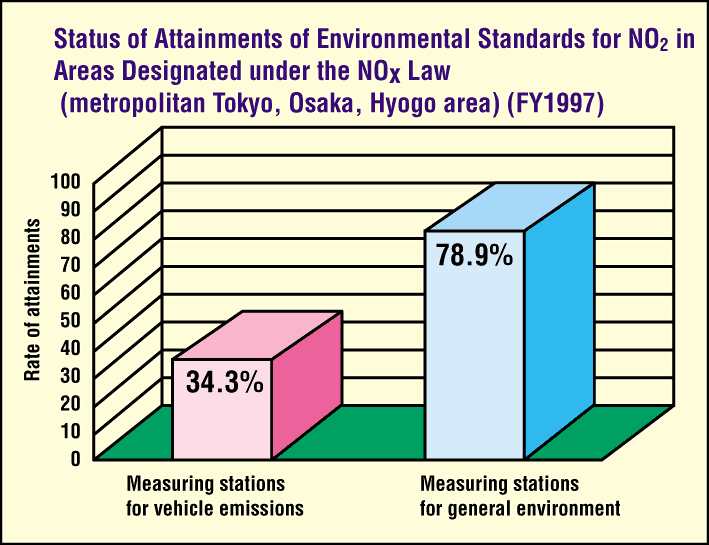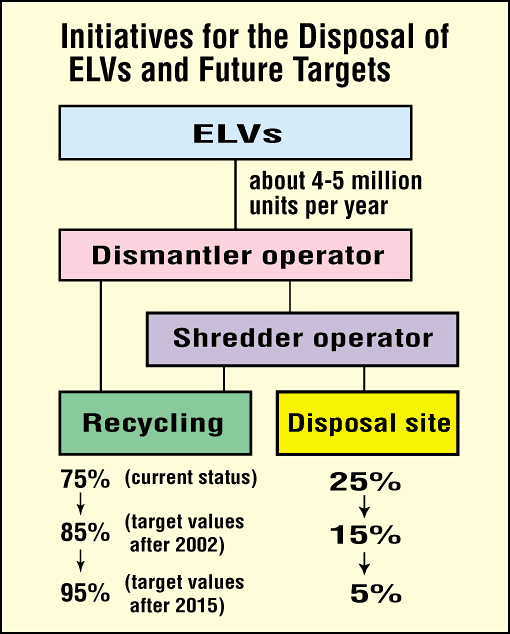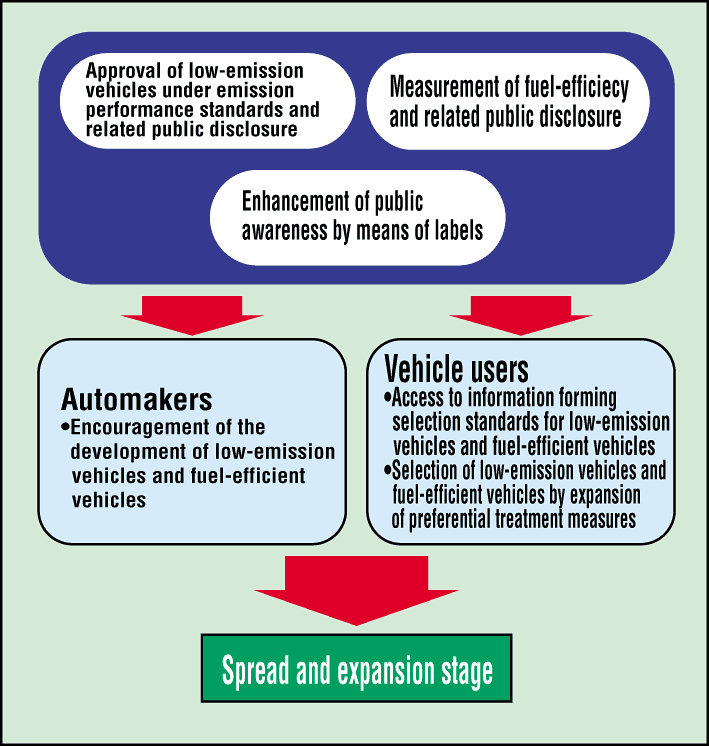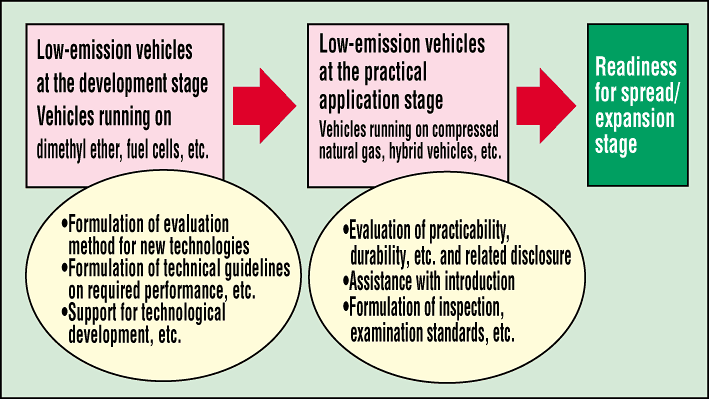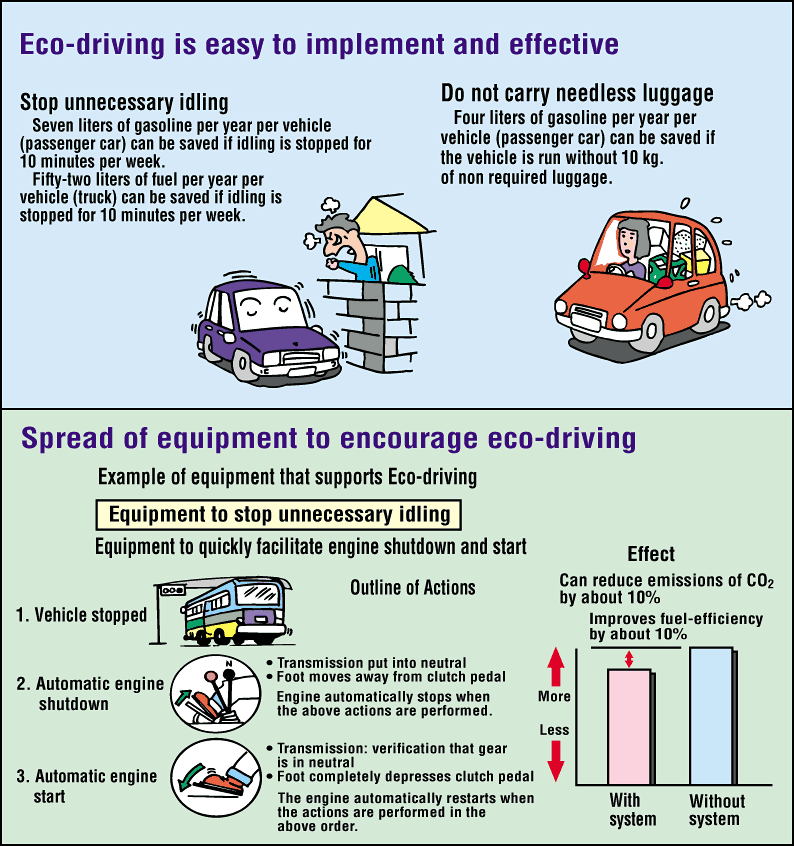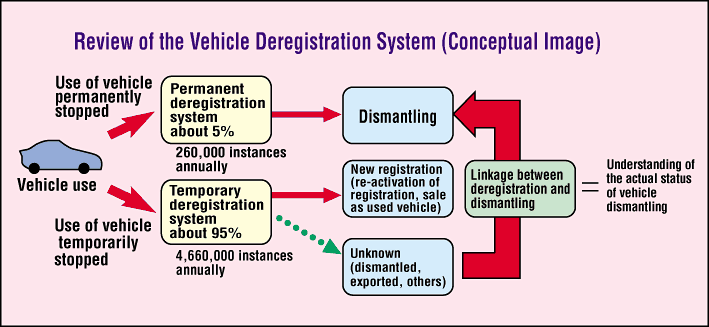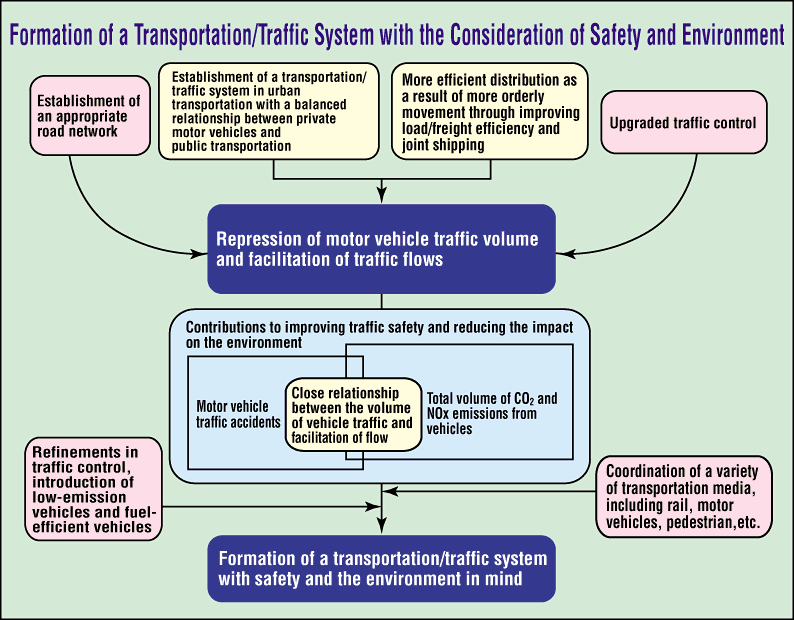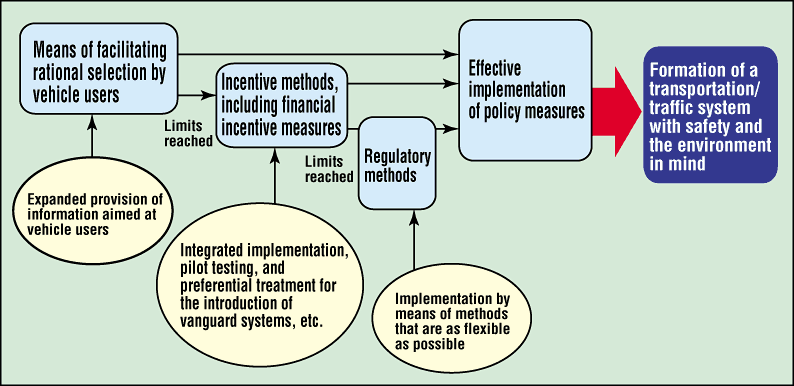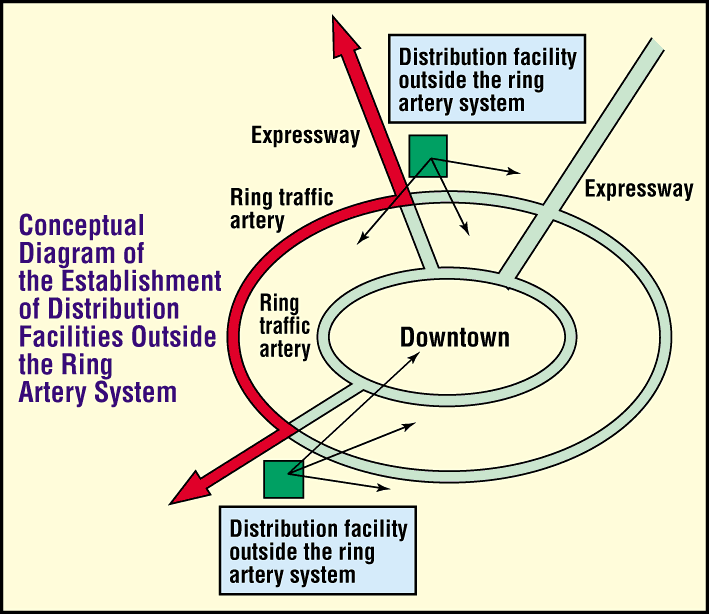The Strategic Plan of Future Motor Vehicle Traffic Policy Taking Due Regard of Safety and the Environment
Outline of the Report for The Council for Transport Technology
The Council for Transport Technology, having received an inquiry (Request for Advice No. 24) from the Minister of Transport on June 16, 1998 for advice on "the Strategic Plan of Future Motor Vehicle Policy Measures Taking Due Regard of Safety and the Environment," proceeded to conduct an inquiry into the matter. Three subcommittees were established: the Safety Subcommittee, the Environment and Traffic Systems Subcommittee, and the Inspection and Maintenance Subcommittee.
As part of its tasks, the Council issued its first report on its inquiry into the inspection and maintenance system in December 1998 (not included in these materials): The Council then put together a summary of its inquiry findings regarding the remaining items of the inquiry, namely: 1) The Strategic Plan of Safety Measures Related to Motor Vehicle Traffic, 2) The Strategic Plan of Environmental Measures Related to Motor Vehicle Traffic, and 3) The Strategic Plan of Motor Vehicle Transportation/Traffic System with Safety and the Environment in Mind.
 |
![]()
![]()
1. Extremely serious current situation of traffic accidents
The number of traffic accidents and traffic fatalities and injuries involving motor vehicles has been rising steadily in recent years. An examination of the number of fatalities and injuries according to statistics compiled by the National Police Agency reveals an increase from approximately 760,000 fatalities/injuries in 1988 to approximately 1,000,000 fatalities/injuries in 1998. This represents an increase of about 30% over a ten-year period.
A breakdown of the number of fatalities shows a declining trend over the past several years as the result of a variety of measures. Nonetheless, statistics compiled by the Ministry of Health and Welfare of traffic accident fatalities occurring within one year following the accident indicate about 14,000 deaths per year.
Injuries, in contrast, seem to be increasing. About 990,000 persons suffered injuries in traffic accidents in 1998, topping the record worst year set in 1970, when about 980,000 persons were injured in traffic accidents. This year, the pace appears to be increasing. As of the end of April 1999, about 317,000 persons have suffered injuries, with the rate of injuries running about 7% over the level of 1998, which was the worst year ever. The increase in the number of injured persons is not stopping.
![]()
2. Why are so many traffic accidents occurring and what measures should be undertaken to counter this?
Most traffic accidents are attributable to human factors (errors by the driver). Nonetheless, in the background there is the possibility of the presence of problem points in areas such as vehicle structure, the running environment, or in operation management, all of which may lead to errors by the driver.
![]()
3. How best to proceed with the motor vehicle traffic safety policy
Devising truly effective motor vehicle traffic safety policy measures will require certain steps. First of all, it will be important to expand the collection of data on accidents as a ground-laying step. Then it will be necessary to regularly conduct a wide range of analyses of the various underlying factors, in addition to determining the direct cause of the accidents, so as to gain an understanding of the accident situation. Having accomplished that, it will be essential to then look repeatedly to the total picture and at each segment of the total picture in terms of the cycle of motor vehicle traffic safety measurers (the setting of targets for reduction--implementation of countermeasures --evaluation of results --the setting of new, lower targets) centered on the "understanding of the real accident situation." (This means shifting from an approach centered on the "car users' morality, i.e., adherence to traffic rules, etc." to a data-centered approach.)
![]()
4. What should the government do about the motor vehicle traffic safety policy?
Motor vehicle traffic accidents can not only cause serious physical and economic damage and mental anguish to the injured parties but also may have a great impact on third parties. In view of the spread of motor vehicles and accidents, anyone may either suffer injury in a traffic accident or cause injury, and this is a social problem. It is not proper to leave traffic accident safety measures to the action of market principles as such safety measures have no direct bearing on profits or benefits. This situation will require the active intervention of the government or public sector, including close liaison with traffic safety-related government ministries and agencies and a greater emphasis by the government as a whole on comprehensive countermeasures.
![]()
5. Reduced targets related to MOT's safety measures
MOT has set reduced provisional targets for the year 2010 related to its safety measures in the following sectors.
Target by individual sector:
Vehicle stucture safety policy: The number of fatalities (mortality within 30 days following the accident; the same hereinafter) is to be reduced by 1,200.
Commercial vehicles' operation safety policy: The number of accidents involving commercial vehicles is to be reduced by 20% (corresponding to a reduction of approximately 170 fatalities).
Overall target of MOT's policy measures:
The overall target is to reduce the number of fatalities by 1,500 by means of a comprehensive approach consisting of such measures as the formation of safety-oriented traffic systems in addition to MOT's safety measures for vehicle structure and commercial vehicle opration.
![]()
6. Points requiring attention when implementing motor vehicle traffic safety measures
There are at present demands for deregulation, especially with respect to economic regulations. Safety regulations, however, should not heedlessly take the path of deregulation. Instead, the need for and results of safety regulations should undergo thorough examination and such regulations should be expanded as needed.
Safety policy measures should be combined with guidance measures that take advantage of market principles so that vehicle users, prompted by information about safety, will make appropriate selections.
Technological advances will contribute greatly to safety measures. It will, therefore, be important to adopt safety regulations and safety guidance measures that will encourage technological development, including the development of sophisticated Intelligent Traffic Systems (ITS).
In view of the fact that Japan is entering the era of the aging society, it will be essential to examine effective measures to prevent accidents involving senior citizens.
![]()
A comprehensive understanding of the real situation of accidents derived from the collection and analysis of accident data will be essential in every segment of the vehicle traffic safety policy measure cycle so as to be able to set reduced targets, implement the measures, and make effective evaluation of the results. Safety measures carried out without such an analysis are in effect "practicing medicine without recourse to postmortems." An accurate understanding of the real accident situation is the foundation of the vehicle traffic safety policy measure.
![]()
Commercial vehicles have special safety problems depending on the category of business, and at the same time accidents involving such vehicles may often have great social effects. As a result, safety measures for commercial vehicles require appropriate, carefully considered responses.
The causes of accidents are usually believed to be attributable to errors made by drivers. However, in the case of commercial vehicles, it is important to look not only at drivers' errors, but also to identify the problem points that may be buried out of sight in transport operators' business routines so as to derive maximum benefit from an expansion of safety measures aimed at parties in the transport business.
![]()
Ensuring vehicle safety requires both advances in the development of safer vehicles as well as efforts to facilitate the spread of such vehicles. At the same time, it will be important to raise the awareness of vehicle users regarding the proper ways to use their vehicles.
![]()
1. The necessity of vehicle safety measures
While the rising number of vehicles in use is leading to pressure for an increase in accidents, technological advances are setting the stage for broader expectations of the benefits resulting from vehicle safety measures. Vehicle safety measures will be important more than ever.
![]()
2. The process of undertaking measures
The importance of adopting an approached focused on critical areas.
![]()
There are social needs not only to make liability insurance payments under the self-compensation system more equitable, but also for measures to assist persons injured in traffic accidents and ameliorate damage.
![]()
Here it will be important to give due thought to not placing an excessive burden on vehicle users by, on the one hand, facilitating the emplacement and expansion of projects with major policy measure effects and, on the other hand, reducing the budgets and undertaking the rationalization of projects that will yield only minor results.
 |
![]()
1. Why are vehicle-related environmental measures necessary?
The issue of global warming, a problem confronted jointly by mankind Serious air pollution continues, centered in major urban areas The problem of disposing of end-of-life vehicles
![]()
2. How to proceed with vehicle-related environmental measures
Environmental issues are issues that can not be resolved by depending on market principles; economic incentives and regulations will be required. Moving ahead with environmental measures will require combining a variety of measures such as the strengthening of regulations on vehicle emissions and fuel-economy standards, the spread of low-emission vehicles and fuel-efficient vehicles, and incentives to promote eco-driving and to introduce traffic systems with minimal impact on the environment. It will be appropriate to encourage environmental measures that harmonize with the convenience of the motor vehicle rather than impair the convenience of traffic as a whole. Global environmental issues should be addressed nationwide under a steady, long-term approach. Nonetheless, air pollution attributable to NOx is thought to be a local problem and should therefore be resolved as soon as possible. It will be important to adopt the following approachäčto set volume targets, to check results regularly, and to review countermeasuresäčto the extent that this approach is applicable to individual countermeasures.
![]()
3. Approach to the global warming issue
Countermeasures aimed at the transport sector will be important in order to achieve the targets for reduction stipulated in the Kyoto Protocol of COP3.
![]()
4. Approach to stopping air pollution caused by NOx
Air pollution caused by NOx, suspended particulate matter and other items, in major urban centers, remains a serious problem. To master this problem will require a wide-ranging re-examination of measures taken thus far and the establishment of schemes to promote new approaches.
![]()
5. Progress of recycling in the motor vehicle sector
To promote recycling in the motor vehicle sector and to pave the way for the advent of a closed-circulation type of society will require a further strengthening of initiatives to stop illegal dumping and to improve the rate of recycling.
![]()
Tightening emissions regulations and fuel-economy standards
Tightening emissions regulations
The formulation of fuel-economy standards under the concept of the "Top-runner" method
Trade-offs between emissions and fuel-efficiency
The creation of an approval system for low-emission vehicles
Popularization by distinguishing low-emission vehicles, etc. through labels
Support for low-emission vehicles at the practical application stage
Support for low-emission vehicles under development
Measures to maintain the emissions performance of vehicles in use
Examination of the introduction of surveillance testing Examination of simplified emission inspection methods
![]()
It is necessary to consider preparation to encourage commercial vehicle operators to take heed of the driving environment and to firmly instruct them to observe Eco-driving in order to prevent unnecessary idling for long periods by commercial vehicles.
![]()
Action by commercial transport operators will be effective
Encouraging commercial transport operators to shift to low-emission vehicles and fuel-efficient vehicles will be very effective because the vehicles of operators in the transport business are mainly large trucks and run on average three times the distance run by vehicles as a whole; therefore, the benefits of measures per vehicle will be much greater.Comparison of Commercial Trucks with Privately-owned Trucks
Ratio of large trucks Ave. running distance per day per truck Commercial trucks 44% 230 km. Privately owned trucks 3% 90 km. Commercial trucks/ privately owned trucks 14.7 2.6
(As of the end of March 1998)
Note: "Large trucks" refers to motor vehicles with GVW of 8 tons or more. "Ave. running distance" is in comparison to ordinary truck.
Comparison of Tonnage Transported by Truck
(As of the end of March 1998)
No. of tons transported by unit-truck per day Commercial trucks 7.1 tons Privately owned trucks 1.3 tons Ratio of commercial trucks/ privately owned trucks 5.5 Establishment of expanded support for replacement buying low-emission vehicles and introduction of targets
Consideration must be given to expanding support for a variety of measures to favor the introduction of low-emission vehicles by commercial transport operators and to the setting of percentage targets for the introduction of such vehicles by commercial transport operators as well as public disclosure of the operators' target achievement scores.
![]()
Encouragement of the proper disposal of ELVs by review of the vehicle deregistration system
Encouragement of design and production of easy-to-recycle vehicles
Consideration must be given to measures that encourage the design and production of easy-to-recycle vehicles, including the devising of an Strategic Plan for the dissemination of information on new vehicle recycling.
Promotion of the use of recycled parts into vehicles
In view of diffusing and promoting the use of recycled parts, consideration must be given to schemes that display options of parts selection to the vehicle user, expand the parts inventory information, and eliminate the distribution of inferior parts.
 |
![]()
![]()
1. It will be important to modify the strategic plan of the transportation/traffic system so as to facilitate the smooth flow of traffic and reduce the volume of vehicle traffic without impairing the convenience of motor vehicle transportation.
The safety of motor vehicle transportation and the total volume of CO2 and NOx emissions from vehicles are closely related to the volume of traffic and how smoothly the traffic flows. Beneficial modifications to the framework of the ideal transportation/traffic system designed to reduce the volume of vehicle traffic while facilitating the traffic flow will contribute to improving vehicle traffic safety and reducing the impact on the environment. Therefore, policy measures should be implemented as much as possible by incentive and in a natural fashion to assure retaining the convenience of the transportation/traffic system.
![]()
2. How should policy measures be implemented?
1) Policy measures must be implemented effectively in appropriate combinations including the expanded provision of information, use of incentive methods, and regulatory methods, to create market functions effectively.
2) Execution of the policy evaluation
Efforts must be undertaken to enhance the understanding and acceptance of policy measures among vehicle users, residents, and other related parties by improving the consistency and appropriateness of policy evaluations through development/enhancement of evaluation methods as well as by public disclosure of the findings of the evaluations in an easy-to-understand format.
![]()
3. Necessity of examination centered on policy measures related to facilitating urban traffic and improving the efficiency of distribution
Demand for urban transportation is converging, driven by a wide range of objectives. Here, it will be necessary to constrain the volume of vehicle traffic and facilitate traffic flows by devising a transportation/traffic system that strikes a balance between private vehicles and public transportation.
As it will be important to improve the efficiency of main channel distribution on main traffic arteries, it will be necessary to examine integrated means of enhancing both main channel and regional distribution.
![]()
4. Use for new info-communications and vehicles, technology
Important issues include the active application of Intelligent Transport Systems (ITS) based on new info-communications technologies and the development of next-generation buses by taking advantage of new technology about vehicles' design , etc.
![]()
Demand for urban transportation is converging, driven by a wide range of objectives. Here, it will be necessary to facilitate the use of public transportation by making it easier to use and more accessible, and by creating urban areas that are designed to facilitate the use of public transportation. Here, it will be desirable to devise a transportation/traffic system that strikes a better balance between private vehicles and public transportation in a new configuration with more forethought to safety and the environment and to seek ways to constrain the volume of private vehicle traffic in urban centers.
Policy measures should be implemented in a concentrated manner in the following instances:
1) When introducing synthetic policies which are not only separate policies but also combination of multiple policies; 2) When enhancing effectiveness by introducing integrated systems consisting of abstract measures (the soft aspect) and of real infrastructure (the hard aspect); 3) When highlighting social effects by selecting model region that undertake a concentrated implementation in those regions, and using the impetus therefrom to expand the implementation nationwide; 4) When making active use of pilot testing; 5) When introducing vanguard systems; and 6) When introducing systems that have high introduction costs and does not work in accordance with market principles despite significant effective of introduction to be expected.
Moreover, it will be necessary to achieve synergy by coordinating the above measures with related measures such as the stimulation of central urban districts and the creation of cities friendly to the aged and the promotion of tourism within urban areas.
![]()
Here, it will be necessary to carry out an approach focused on key points such at the establishment of distribution facilities outside the ring traffic arteries that encircle urban centers. This will be accomplished by implementing policy measures that effectively incorporate three perspectivesäčthe improvement of load efficiency, the improvement of driving efficiency, and the amelioration of the environmental impact associated with individual private-sector drivingäčall three of which are essential to the formation of transport/traffic systems that contribute to distribution efficiency.
Effects of the establishment of distribution facilities outside the ring artery system
Reduction of the total volume of trucks to flow into the downtown area Potential of introducing larger trucks into main channel distribution The distribution facilities will become bases for joint main channel transport and joint delivery within cities
![]()
It will be necessary to reinforce the approach to ITS while giving due consideration to support for the safe driving of motor vehicles and the upgrading of driving control in certain areas, such as encouraging the use of public transportation and improving the efficiency of distribution.
Here the government should carry out policy measures focused on key points.
Encouragement of the development and evaluation of technologies in high-cost, high-risk areas Encouragement of the spread of vanguard systems by providing economic incentives Promotion of the standardization of the system Establishment of technical standards Establishment of infrastructure
Policies that will promote ITS effectively
Establishment of a common platform for the consolidated gathering of a wide range of data on ITS Consideration of the effective use and application of the license plate number system Early declaration of a specific schedule for the introduction of separate systems
Examples of systems that are expected to be introduced:
Real-time Truck Driving System Bus Lane and Public Transport Priority System Supply of Comprehensive Bus Information System Intelligent Taxi Stands
![]()
To facilitate the spread of next-generation bus/vehicles that correspond to issues such as being barrier-free and protection of the global environment appropriately, it will be necessary to undertake efforts to improve convenience of vehicles and lower prices by standardizing basic bus/vehicle structure and to provide focused assistance to such next-generation bus/vehicles.
![]()
Cooperation with developing countries should not solely emphasize the building of infrastructure, but should also give consideration to financial assistance to support the operation of bus enterprises, such as the purchase of vehicles, and to the establishment of a traffic safety-oriented environment, including guidance and training in operating bus enterprises. At the same time, it will be necessary to participate actively in the formulation and establishment of international standards in areas such as ITS and measures affecting the automobile environment.
All Rights Reserved, Copyright (C) 2001, Ministry of Land, Infrastructure and Transport
